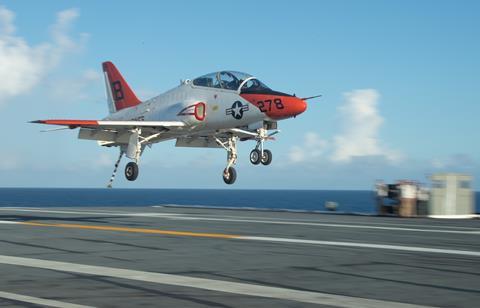Almost six years after the US Navy began investigating a replacement for its Boeing T-45 Goshawk trainers, fiscal year 2025 navy budget documents released this month indicate the service could begin procuring Undergraduate Jet Training System (UJTS) aircraft as early as fiscal year 2026.
However, Naval Air Systems Command (NAVAIR) says it cannot provide details, such as when a contract might be awarded, saying, “The navy is still finalising requirements from the programme.”
That is puzzling, since NAVAIR’s Naval Undergraduate Flight Training Systems programme office issued a Request for Information (RFI) on UJTS aircraft last August. That document said interested aircraft manufacturers should “assume a contract award date of FY2026”, with a full-rate production cadence of “25 aircraft per year for a minimum of 145 total aircraft”.
The US government’s FY2026 starts in October 2025.
The RFI was the latest in a series the service has issued since 2018. NAVAIR describes UJTS as an effort to recapitalise the navy’s intermediate and advanced jet-training capabilities.
“This new aircraft will enhance availability, meet future strike training requirements and provide a platform that aligns closely with strike aircraft that student graduates will operate in the fleet,” NAVAIR says. “The programme will include aircraft, simulators, curricula and associated equipment.”
The navy plans to release a more-specific request for proposal for UJTS once programme requirements have been solidified.

So far, three industry teams have confirmed responding to the navy’s RFIs.
Boeing plans to offer a naval version of its T-7A, the single-engined jet trainer it is developing for the US Air Force to replace the service’s Northrop T-38 Talons. The company says that once the navy completes requirements for the UJTS, Boeing will provide an offer to meet the service’s needs.
Lockheed Martin and Korea Aerospace Industries are teaming to offer the TF-50N, a naval version of the single-engined jet trainer already in service or on order as the T-50 with seven countries.
Lockheed says the “inherent modularity of the platform is a strength, enabling the team to incorporate systems and capabilities to meet the navy’s needs”.
Finally, Textron Aviation Defense and Leonardo have jointly proposed a naval version of the twin-engined M-346 jet trainer, known as the M-346N. Already in service with Italy, Poland, Singapore, Israel, Greece and Qatar, the M-346 is a proven, low-risk advanced integrated training system, according to Textron.
The navy’s FY2025 budget documents outline a range of challenges for the existing 193-aircraft T-45C fleet, including “significant aircraft, engine, and component obsolescence issues”.
These are projected to dramatically increase operating costs and aircraft availability by 2030, the service notes.
The minimum number of UJTS aircraft specified in the August RFI would be 53 fewer than the current T-45C fleet. The difference might be explained by the RFI’s focus on assessing industry’s ability to develop and produce a land-based jet trainer “capable of field carrier landing practice training, to include touch down on land (no carrier environment)”.
That means UJTS aircraft replacing carrier-capable T-45s need not be capable of operating from aircraft carriers, but would need to be capable of flying the carrier-landing approach profiles that student pilots train for over land, prior to actually landing on carriers.
NAVAIR declines to specify if the navy might retain some T-45Cs to use for training pilots to land on and launch from carriers.
The navy’s Lockheed Martin F-35Cs do have some autoland capability via the Joint Precision Approach and Landing System, which provides all-weather precision landing assistance.
But the service’s Boeing F/A-18E/F Super Hornets and EA-18G Growlers (the backbone of carrier aviation now and for at least the next decade), as well as its Northrop Grumman E-2D Hawkeyes, do not have autoland capability. The navy does, however, have a system for F/A-18E/Fs and EA-18Gs called Precision Landing Mode (PLM), which significantly reduces the need for pilot inputs, simplifying carrier landings.
“This new flight-control technology drastically reduces the number of inputs a pilot must make on final approach to the carrier,” NAVAIR said in 2021, shortly after delivery of the PLM system. ”With its optimised control laws and tailored displays, PLM eases pilot workload and makes landing much safer and simpler.”
The navy in 2021 said the introduction of PLM would also change how it trains pilots, who will use the system starting on “day one”.



















